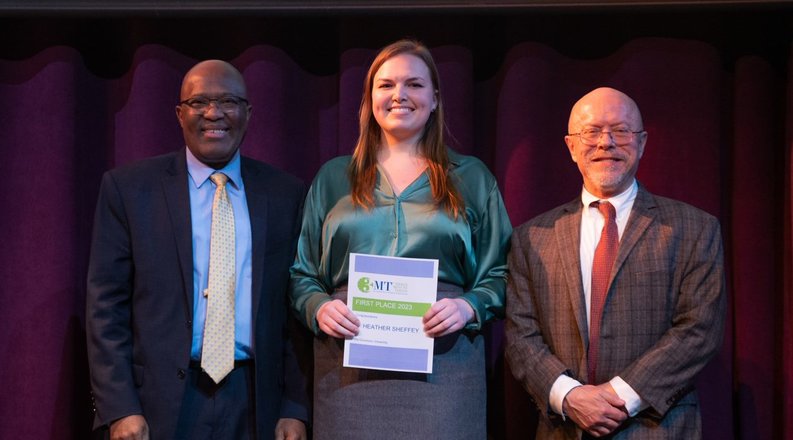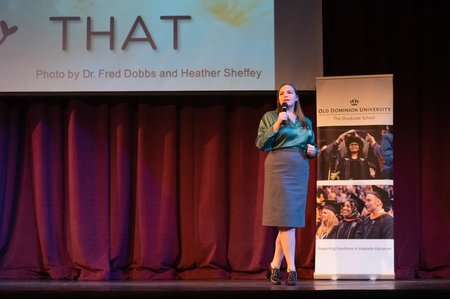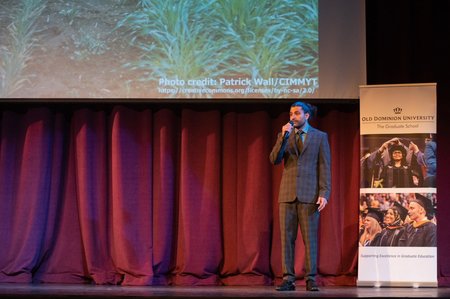Heather Sheffey, a master’s candidate in ocean & earth sciences, won Old Dominion University’s sixth annual 3-Minute Thesis (3MT®) competition on Jan. 20 at University Theatre. Her research focused on the effects of microplastics and disease on temperate coral.
Sheffey was one of five competitors representing two academic colleges during the event, which was viewed by in-person and virtual audiences. She earned a $1,000 prize and a spot in a regional competition hosted by the Conference of Southern Graduate Schools in Tampa, Florida, in March.
The 3-Minute Thesis competition was launched by Australia’s University of Queensland in 2008. The event, which gives students three minutes to present their scholarship in such a way that a general audience could understand and appreciate its significance, has been adopted in 85 countries outside of Australia. Old Dominion, which has approximately 4,800 graduate students, is one of 358 participating institutions in the United States.
“Just imagine for a minute that you are asked to come on stage, to present your research – something that you have been working on for the last two or three years – and to present it all in three minutes, and do so in a way that the average Joe can understand,” said Austin Agho, provost, vice president for academic affairs and interim vice president of student engagement and enrollment services. “That is not an easy task.”
“The skills learned and performed tonight are a substantial and key part of what we do,” added Robert Wojtowicz, vice provost and dean of the Graduate School, which sponsored the event.
Sheffey’s presentation, “Don’t Eat That! Effects of Microplastics and Disease on Temperate Coral,” centered on the Northern Star Coral, which stretches in Atlantic waters from Maine to Florida.
“It’s a part of our biodiversity,” she said, adding that it can help maintain the shape of our coastlines by acting as wave breakers and play an important role in our food supply and even tourism. “This is our local environment.”
But these corals are ingesting microplastics, which are the size of a pencil-head eraser or smaller and are polluting the world’s marine environments. “They can support coral disease-causing bacteria,” said Sheffey, whose faulty mentor is Fred Dobbs.
Her research exposed corals to these microplastics over two weeks and recorded the effect on their health. She found that they make the corals “more tired.”
“Let’s say you’ve got the flu,” she explained. “As you’re getting sicker, movement you’re used to becomes much harder. You start huffing and puffing just to get something from the kitchen.
“Corals with higher respiration rates are really huffing and puffing.”
In fact, Sheffey found that the corals she exposed to microplastics had a respiration rate 652% higher than her control group.
She urged the audience to adopt sustainable practices.
“Together, we can reduce our plastic waste and keep our corals healthy,” she said.
Gyan Kharel, a chemistry doctoral candidate, took the $750 second-place prize and the $500 Peoples’ Choice Award, which was voted on by the audience, for his presentation: ‘I Don’t Want to Starve: A Story of Biochar and Phosphorous.” His faculty mentor is James Lee.
Phosphorous, which is used in fertilizers, is vital for food production. But Kharel said phosphorus rock in mines is unevenly distributed around the world.
“Only a few countries hold the world’s remaining reserves,” he said. “The United States has enough reserves to last only about 20 years.”
Furthermore, he added that plants use about one-fifth of the applied phosphorous, with the rest deposited in soil in a form that is unavailable for plant uptake.
His research looked at using biochar, a black carbon produced by heating plants at high temperatures in the absence of oxygen, to recapture this unused phosphorous for future use.
The result of his study showed promising results, with ozonized biochar releasing up to 80 times more phosphorous than his control material.
“With a world population that is projected to reach 9 billion by 2050 and a growing global middle class that is consuming more meat and dairy, phosphorous is crucial for global food security,” he said. “This ozonized biochar enhanced chemistry may provide a new research opportunity for scientists to explore a new possible way to unlock phosphorous from locked phosphate material and help in the sustainability for agroecosystems.”
The other competitors and their topics were:
- Megan Strowger, Ph.D., psychology (health psychology), “Don’t Picture This: Exploring the Link Between Seeing Alcohol on Social Media and College Drinking Over Time,” faculty mentor – Abby Braitman
- Ricardo Randall, Ph.D., education (educational leadership), “Moving On Up! Getting Students Ready for Ninth Grade,” faculty mentor – Steve Myran
- Samantha Fitzer, M.S., psychology, “Get Your Head Out of the Clouds: The Connection Between Sexual Identity and E-Cigarette Use,” faculty mentor – Matt Henson
The judges were Brian Collister, who received a Ph.D. in oceanography from ODU in 2021 and is a Fellow in the postdoctoral program at NASA Langley Research Center in Hampton; Kindra Greene, executive director of the Elizabeth River Tral Foundation; and T.A. Warren, commander in the U.S. Navy and engagement branch chief for the Joint Reserve Intelligence Program, Defense Intelligence Agency. Barbara Hamm Lee, executive producer and host of WHRV’s “Another View,” served as emcee.





